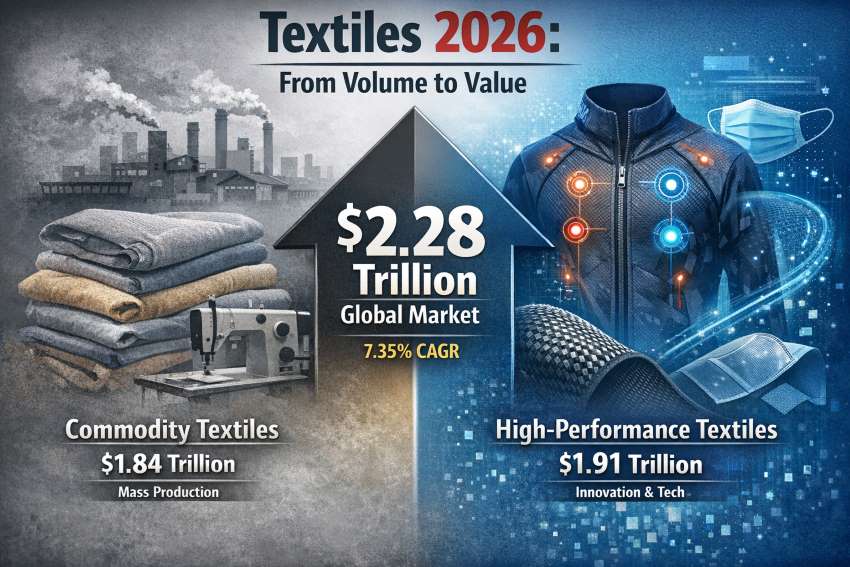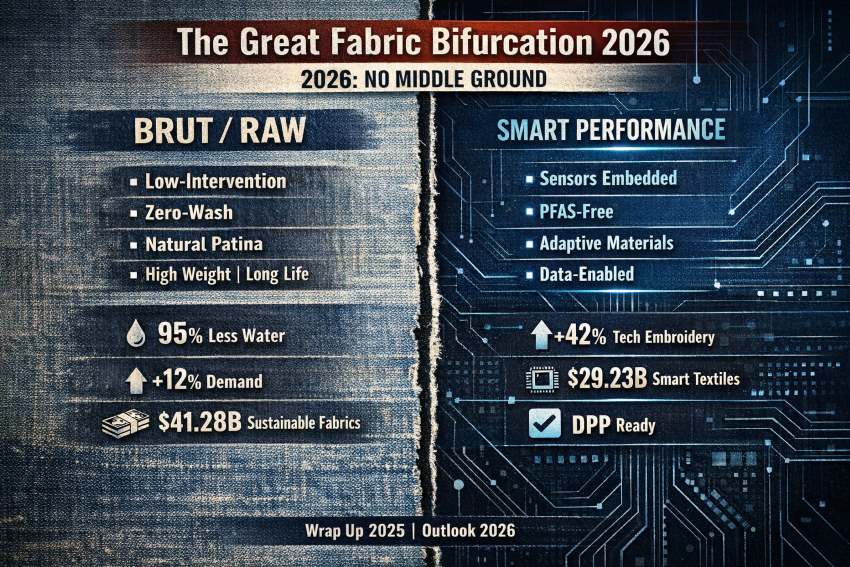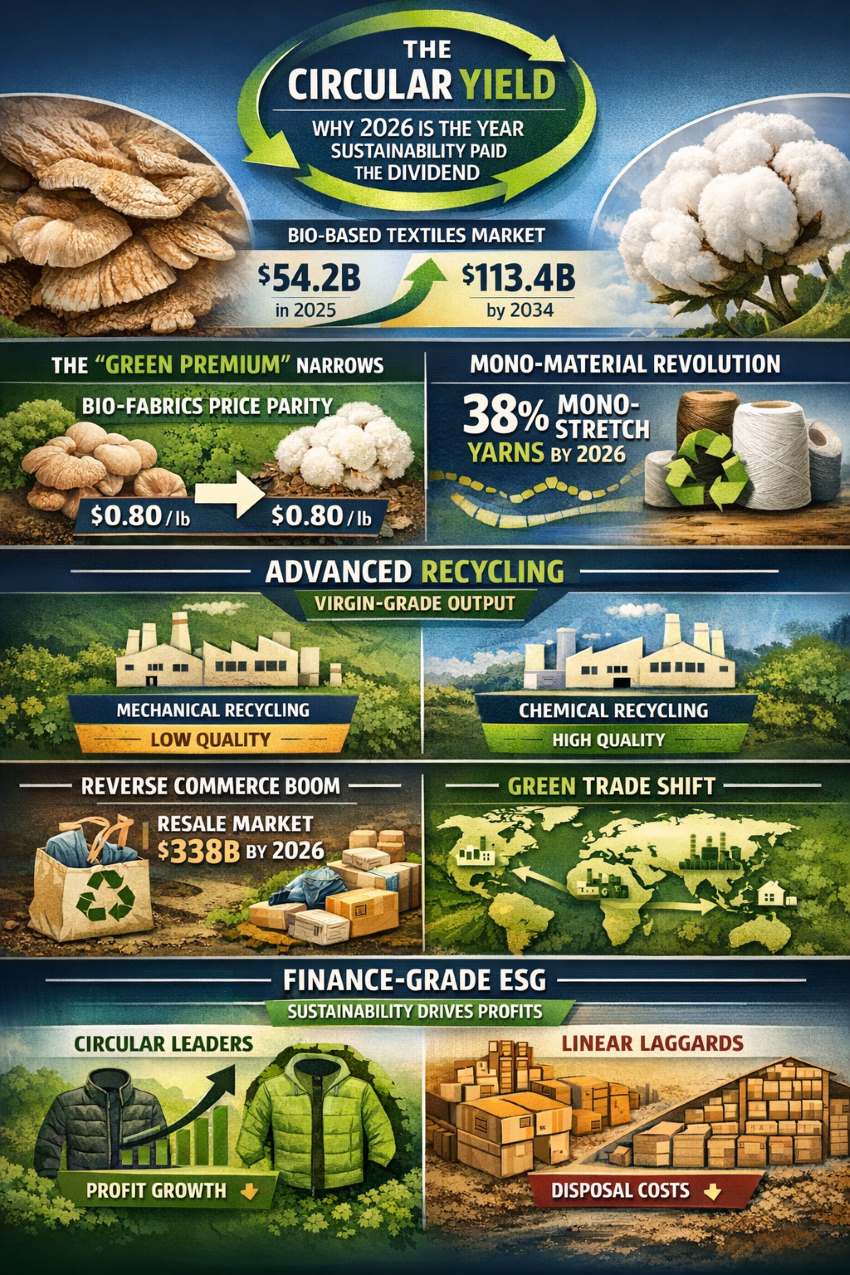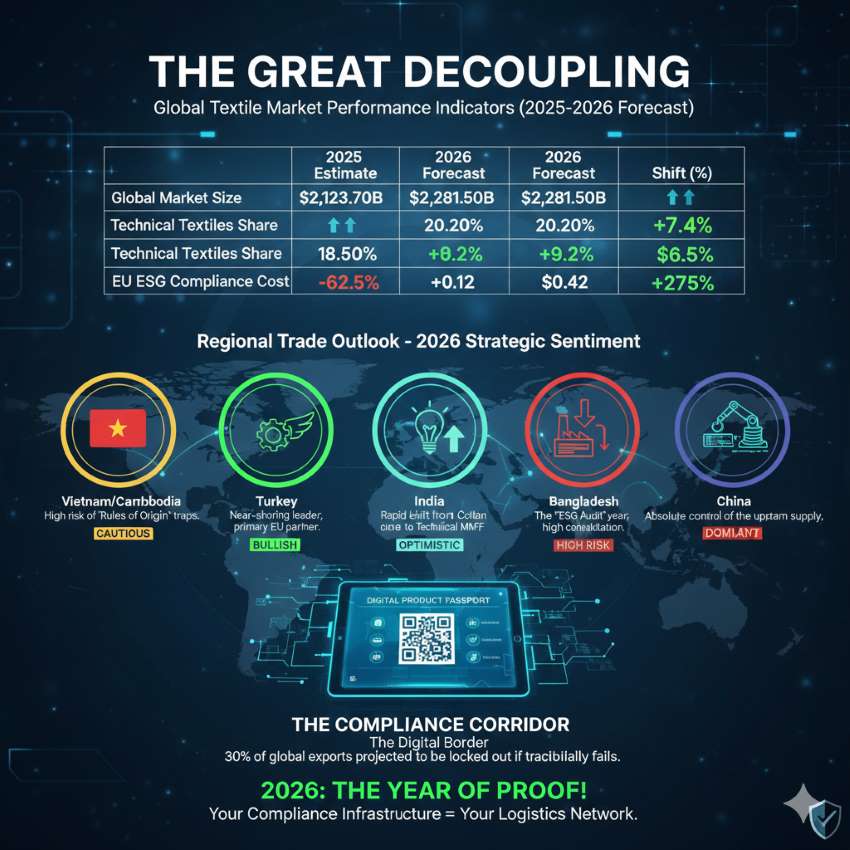FW
The global textile and apparel industry is undergoing a structural realignment as New York cotton futures maintain an eight-week peak of 65.76 cents per pound as of early 2026. Fueled by supply constraints in the United States and Brazil, this upward trajectory is fundamentally altering procurement logic. Historically, apparel manufacturers migrated toward synthetic fibers to mitigate costs; however, current energy market volatility- linked to geopolitical instability in South America—has inflated polyester production expenses. Consequently, the price delta between natural and man-made fibers is contracting, prompting a strategic return to cotton-rich blends for high-volume retail lines.
Supply deficits drive strategic procurement
The MY 2025/26 is characterized by a ‘flight to quality’ amidst tightening availability. While global production is estimated at 119.8 million bales, the United States has seen harvested areas decline to nearly 1.45 million acre - a decade-level low - as growers prioritize higher-margin commodities like soybeans. This supply-side pressure is exacerbated by intensive short-covering in the futures market. Market analysts indicate that the current rally is less about a surge in consumer demand and more a result of institutional investors liquidating large short positions as they hedge against anticipated acreage reductions in key exporting regions.
Manufacturing localization and sector impact
For the $1.91 trillion global apparel market, these fluctuating input costs necessitate more resilient supply chains. Projected to reach $17.52 billion by 2033, the Indian sportswear segment serves as a primary example of this shift toward vertical integration. Brands are increasingly adopting localized manufacturing models to insulate themselves from currency fluctuations and logistical bottlenecks. This move towards ‘near-shoring’ is paired with a growing investment in regenerative agriculture, as retailers seek to secure long-term raw material supplies while meeting stringent global sustainability mandates.
The global outdoor sports apparel market is undergoing a fundamental transformation as it reaches a projected valuation of $25.9 billion by the end of 2026. Maintaining a steady compound annual growth rate (CAGR) of 6.8 per cent, this growth is no longer merely a byproduct of increased fitness awareness. Instead, it is being propelled by a sophisticated convergence of textile engineering and digital health. Industry data indicates that the adoption of advanced fabric technologies has increased by 15 per cent Y-o-Y, as consumers increasingly demand garments that offer more than basic weather protection.
Smart textiles and thermal regulation systems
A primary catalyst for this expansion is the integration of ‘intelligent’ fibers capable of autonomous thermal regulation. Leading manufacturers are now deploying moisture-wicking microfibers and UV-protective finishes as standard features. Recent market intelligence reveals a 20 per cent increase in demand for sustainable performance wear, forcing brands to optimize their supply chains for recycled polyester and bio-based synthetics. This shift is particularly evident in the ‘Everyday Adventure’ category, where technical apparel is engineered for both high-intensity mountaineering and urban environments, effectively blurring the lines between functional gear and daily fashion.
Regional growth and strategic localization
The Asia-Pacific region is emerging as the fastest-growing geographical segment, fueled by rising middle-class disposable incomes and a 171 per cent increase in hiking participation since 2020. To mitigate global logistical risks, major players are shifting toward localized manufacturing hubs. For instance, contract manufacturers are expanding BIS-certified facilities to serve athletic giants like Adidas and Puma domestically. Despite challenges such as raw material price volatility for nylon and spandex, the sector’s focus on high-margin, multi-functional products - such as 2-in-1 hybrid leggings and convertible modular jackets—continues to secure robust financial performance across global retail channels.
The outdoor performance apparel industry specializes in technical clothing for hiking, cycling, and adventure sports. Focused on North American and Asia-Pacific markets, the sector is currently scaling smart-textile integration and sustainable production lines. Following a record 25 per cent growth in e-commerce sales, the industry outlook remains bullish, supported by a century-long evolution from basic wool layers to high-tech, GPS-integrated wearables.
Asics Corporation is scaling its global R&D footprint, committing $25 million to establish its first-ever American research facility. Based in Ann Arbor, Michigan, the Asics Institute of Sport Science (ISS) America marks a significant shift in the Japanese brand's strategy to localize innovation for its largest growth market. In partnership with the University of Michigan, the center will operate as the ‘Asics-Michigan Sport Innovation Center,’ uniting biomechanics, robotics, and AI-driven textile engineering to engineer the next generation of performance apparel and footwear.
Engineering the future of high-performance retail
This move is a cornerstone of the company’s Mid-Term Plan 2026, which prioritizes a ‘Global x Digital’ approach to reclaim leadership in the premium running category. By embedding researchers within the US sports ecosystem, Asics aims to reduce the product development cycle through rapid prototyping and real-time data from elite North American athletes. The facility will house a dedicated sports lab focused on bioengineering and AI-driven design, moving beyond traditional shoe-making into ‘human-centric science’ that analyzes how specific materials interact with the human nervous system and movement patterns.
Strategic market capture and financial resilience
The investment follows a period of robust fiscal health for the brand. Asics reported a 21.3 per cent global sales increase in late 2025, with North American net sales rising nearly 8 per cent Y-o-Y. As competition intensifies from digital-first entrants and established rivals, the Michigan hub provides a critical competitive moat. ‘Establishing this research entity in the United States—home to a key market for our future growth - is a source of great pride,’ states Mitsuyuki Tominaga, President and COO, Asics Corporation. The move is expected to drive operating margins toward a target of 17 per cent, leveraging high-margin performance lines like the Gel-Nimbus and Metaspeed series.
Asics is a leading designer of performance athletic footwear and apparel, operating across North America, Europe, and Asia. Under its 2026 growth roadmap, the company is targeting record operating income of 130 billion yen ($860 million approx.) by 17 per cent margin optimization. Founded in 1949 as Onitsuka Co, the brand remains synonymous with technical excellence in marathon running and core performance sports.
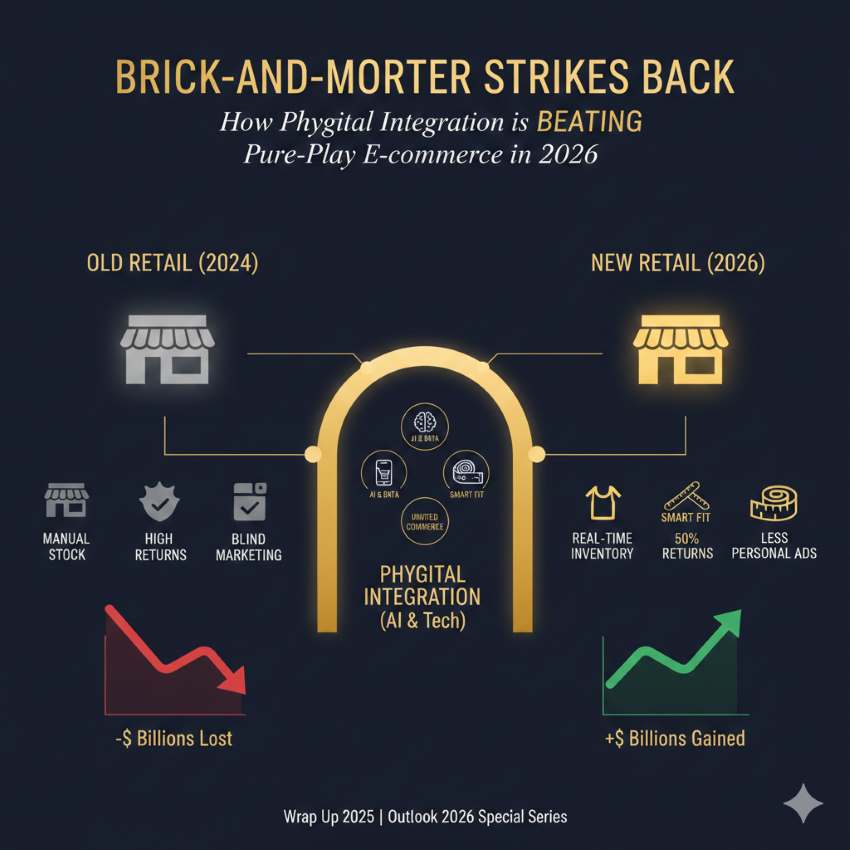
This feature marks the final installment of our special series, Wrap Up 2025 | Outlook 2026, exploring the tectonic shifts in global commerce.
For a decade, the narrative of fashion retail was a eulogy for the physical store. The "Retail Apocalypse" was supposed to be the final chapter for brick-and-mortar, as algorithms and one-click checkouts moved the theater of consumption to the palm of the hand. But as we enter 2026, a surprising plot twist has emerged. Artificial Intelligence, the very force that threatened to digitize fashion out of existence, has become the savior of the storefront through a seamless phygital integration. In the flagship boutiques of Milan, the high-street staples of London, and the sprawling malls of New Jersey, the "Smart Store" is no longer a concept, it is a high-performance engine. By weaving AI into the literal and figurative fabric of the business, retailers are finding that the most potent version of technology isn’t one that replaces the human experience, but one that creates a phygital ecosystem that is hyper-efficient and deeply personal.
Ending the guesswork in buying and stocking
The most radical transformation is happening where the customer never looks: the warehouse and the back office. Historically, fashion has been a game of "guess and distress", buyers guessed what would be hot, and retailers sold the excess at a loss. Today, AI has replaced the crystal ball with a data-driven compass that synchronizes online trends with physical shelf space. At the sourcing level, high-level logistics systems now monitor global shifts, weather patterns, and shipping bottlenecks to reroute goods before a delay even occurs. In 2026, the gap between a trend appearing on social media and the physical garment arriving on a shelf has shrunk from months to mere weeks. Inside the store, the change is palpable. Sensors paired with computer vision systems mean "out of stock" is becoming an archaic phrase. AI-driven demand forecasting now analyzes local events; a concert across the street or a sudden drop in temperature, to prompt immediate shelf replenishment. For the offline retailer, this means the billions annually lost to overstock and stockouts is finally being reclaimed.
Solving the "Fit Crisis" and slashing return rates
Perhaps the most significant breakthrough in 2026 is the technological conquest of the "Fit Issue" through phygital innovation. For decades, inconsistent sizing across brands was the primary driver of customer frustration and a staggering 30% or more return rate in e-commerce. AI has finally bridged this gap by turning the physical store into a precision-measurement hub for the digital world. High-street retailers have replaced traditional tape measures with 3D Body Scanning booths and AI-powered "Fit Concierges." These systems capture thousands of data points in seconds, creating a "Digital Twin" of the shopper. When a customer stands before an AI-integrated smart mirror, the system doesn't just show them the garment; it calculates the exact drape, tension, and movement of the fabric against their specific body shape. This "True-to-Size" matching has migrated from the shop floor to the user’s mobile app, ensuring that when they later shop online, they are only shown items guaranteed to fit. By solving the fit problem in the physical store, retailers have seen a dramatic 50% drop in returns, protecting margins that were previously eroded by "bracketing", the habit of customers buying three sizes of the same item and returning two.
Knowing the customer better than they know themselves
The power of AI in 2026 lies in its ability to move beyond basic age and gender categories. Traditional marketing focused on broad groups, but AI-driven positioning instead focuses on specific shopping behaviors across the phygital divide. By analyzing billions of data points across social media, search history, and in-store foot traffic, brands can now identify niche audiences and tailor their entire brand identity to resonate with a specific lifestyle. This precision has transformed marketing from an expensive shot in the dark into a surgical strike. In the offline world, this translates to "Hyper-Local Merchandising." An AI analysis of a store’s specific neighborhood might reveal that local shoppers prefer muted tones and structured silhouettes, leading the brand to curate that specific branch’s inventory to match the local style pulse. This level of positioning ensures that the store isn't just a place to buy clothes, but a reflection of the community it serves.
Converting window shoppers into buyers
Walk into a premier fashion outlet today, and the experience is supported by sophisticated systems integrated into smart mirrors and staff tablets. Marketing has moved from shouting at everyone to whispering to the individual, creating a personal phygital journey. Offline stores now use secure, opt-in technology to recognize loyal customers and offer them personalized deals the moment they step through the door. If a shopper browsed a specific suede jacket online but didn't buy it, the in-store smart mirror might suggest a matching silk scarf when they enter the fitting room, offering a real-time bundle discount. This synergy between online data and offline presence has turned the fitting room, once the bottleneck of the retail experience, into a high-conversion discovery zone. Furthermore, tools now allow floor managers to monitor the "emotional temperature" of the shop. By analyzing movement patterns and dwell times, AI can flag if a particular section is causing frustration or if a display is being ignored, allowing for immediate changes to the store layout.
The New Math: Comparing Traditional vs. Intelligent retail
The following data outlines the hard financial shift in operational efficiency across top-tier fashion retailers who have replaced gut-feeling management with AI-driven logic.
|
Financial Indicator |
The Old Way (2024) |
The Intelligent Way (2026) |
Performance Gain |
|
Inventory Turnover (Annual) |
4.2x |
7.1x |
+69% |
|
Cost to Acquire a Customer |
$48.00 |
$31.50 |
-34% |
|
In-Store Sales Conversion |
18.50% |
31.20% |
+68% |
|
Profit Lost to Markdowns |
22% |
9% |
-59% |
|
Product Return Rate (Fit Related) |
30% |
12% |
-60% |
Using the shop floor to win the e-commerce war
One of the most profound shifts in 2026 is the blurring line between the showroom and the delivery hub, defining the true essence of phygital retail. Retailers are now leveraging their physical shops as "Micro-Fulfillment Centers" or "Dark Stores" during off-peak hours. AI algorithms determine which stores have the specific surplus inventory to fulfill online orders for the surrounding neighborhood, drastically reducing shipping costs and delivery times. A flagship store on the main street is no longer just a display case; it is a high-speed node in a delivery network. This integration allows for "Hyper-Speed Local Delivery," where a customer can order online and receive their item from the nearest shop within two hours. This strategy has turned the physical store's high rent from a burden into a massive competitive advantage against online-only giants who lack a local presence.
Real-World Proof: The ‘Tech-Led’ turnaround
The benefits of these tools are being proven daily by industry veterans. A major global sportswear brand recently implemented sensors in its New York flagship to track how customers interacted with a new display. The AI identified that while people were looking at the shoes, they weren't trying them on because the price and technical details were hard to find. The brand adjusted the digital signs in real-time, resulting in a 14% jump in sales that same weekend. In another case, a mid-tier fashion chain used AI to adjust stock between its city and suburban branches. The system recognized a 22% higher demand for work blazers in city centers compared to the suburbs, allowing the brand to move the stock where it was actually wanted before it had to be sold at a discount. This single move saved the company nearly $2 million in just three months.
The Outlook: A new playbook for the C-Suite
For the leadership team, the mandate for 2026 has shifted from simple cost-cutting to a total digital overhaul. CEOs are no longer debating whether this technology works; they are restructuring their entire companies around it. The strategic focus is now on systems capable of making autonomous decisions in the supply chain without waiting for a committee. Chief Operating Officers are breaking down the walls between their "Online" and "In-Store" departments, creating one single team that shares the same data and goals. The focus is squarely on "Margin Recovery"—using technology to stop the waste caused by high returns and unnecessary sales. Leaders are now being judged not just on total sales, but on how much profit they can squeeze out of every square foot of shop floor through smart phygital optimization.
Editor Concludes: Putting the soul back in the sale
The fashion industry has always been about the "New," but for years, its business model was dangerously out of date. The 2026 Pivot proves that the physical store is not a relic; it is an asset that has been rediscovered through the lens of science. By leveraging AI to handle the boring parts; counting stock, predicting demand, and managing delivery, retailers have finally freed their staff to do what they do best: talk to people and help them look their best. The winner in this new era isn't the brand with the most complex computer code, but the one that uses that code to make the physical act of shopping feel personal again. We are witnessing a phygital renaissance where the precision of the computer meets the personal touch of the shopkeeper. The store of the future is not a place where machines replace people, but a place where machines make people more successful.
The global apparel sector is navigating a volatile transition as the traditional digital storefront loses its dominance to third-party conversational interfaces and a revived physical retail landscape. Industry forecasts for 2026 indicate, over 50 per cent of consumers now initiate and complete textile purchases through external applications rather than brand-owned websites. This fragmentation of the buyer journey necessitates a sophisticated approach to Product Information Management (PIM). According to Romain Fouache, CEO, Akeneo, the accuracy and transparency of material specifications have become a brand’s primary competitive advantage in a market where shoppers may never interact with a primary website.
Navigating the AI trust deficit in apparel
Despite the rapid deployment of automated retail tools, the textile industry faces a significant hurdle in consumer confidence. Recent research reveals, only 27 per cent of shoppers who utilized AI-enhanced checkout experiences expressed an intent to repeat the process. This ‘trust phase’ requires manufacturers and retailers to move beyond speculative AI investments, which currently include over 1,300 high-value startups, and focus on practical utility. For the apparel sector, this means leveraging technology to provide granular details on fabric composition, sizing accuracy, and supply chain ethics, as 2025 holiday data confirms that consumer trust is the only sustainable driver of high-value textile sales.
Strategic reversion to physical showrooms
A notable counter-trend in 2026 is the robust return to brick-and-mortar environments, particularly among Gen Z demographics. This resurgence serves as a corrective measure against the high return rates plaguing online-only textile ventures, where products frequently fail to meet physical expectations. By integrating enriched product data within physical stores, formerly digital-native brands are stabilizing their margins and reducing the logistical burden of returns. As the infrastructure of ‘circular shopping’ matures, the successful textile brands of 2026 are those ensuring that every digital data point - whether on ChatGPT or a store shelf—reflects a consistent and verifiable product reality.
Akeneo is a global leader in Product Experience (PX) and product information management, serving major apparel and textile manufacturers across Europe and North America. Originally established in France to solve complex data silos, the firm is currently executing a 2026 growth strategy focused on AI-driven data enrichment. With a strong financial position supported by recent venture rounds, Akeneo continues to scale its platform to help retailers synchronize diverse product catalogs across global, multi-channel ecosystems.
North India’s cotton yarn hubs are witnessing a decisive pricing shift as spinning mills struggle to absorb a 3 per cent M-o-M rise in raw cotton costs. In Ludhiana, mills have implemented price hikes of approximately Rs 2–Rs 5 per kg to maintain viability, though downstream demand from garment manufacturers remains cautious. While the benchmark 30-count combed yarn has seen firmer asking rates, the Delhi market remains largely static, reflecting a disconnect between surging input costs and sluggish retail offtake.
Production realities and margin compression
The domestic spinning sector is grappling with a projected 1.7 per cent decline in cotton output for the 2026 season, which is expected to reach a decadal low of 29.2 million bales. Spinning margins are currently under significant pressure as the cost-to-yarn spread narrows to approximately Rs 96–Rs 100 per kg, notes a senior analyst at ICRA. Despite these headwinds, larger mills are prioritizing export markets to China and Bangladesh to offset weak local demand, which has been dampened by recent 50 per cent US tariff impositions on Indian apparel exports.
Panipat’s recycled ecosystem and oversupply hurdles
Global hub for circular textiles, Panipat presents a polarized landscape. While recycled cotton yarn prices have firmed due to the scarcity of textile waste imports from Bangladesh, the recycled Polyester-Cotton (PC) segment is battling chronic oversupply. Analysts observe, that high-tech recycled fibers are gaining traction in the home textiles sector, yet the abundance of coarse-count PC yarn has prevented price parity with virgin cotton. The sector’s future increasingly hinges on ‘digital passports’ for fiber tracking, ensuring that Panipat’s Rs 60,000 crore turnover can withstand evolving global sustainability mandates.
Ludhiana and Panipat serve as India's primary centers for knitwear and recycled home textiles, respectively. These markets specialize in high-volume cotton spinning and sustainable PC blends for global retail chains. With a 2026 growth strategy focused on automated spinning and circular fashion, the region is adapting to a 1.7 per cent domestic cotton shortfall through increased U.S. imports.
The Japan Fashion Week Organization (JFWO) is marking its second decade by executing a comprehensive structural and visual overhaul designed to transition Tokyo from a regional creative hub to a dominant global fashion capital. Central to this strategic shift is the unveiling of a new identity that replaces the original 2005 logo. This aesthetic transition coincides with the rebranding of the ‘Collection Division’ to the ‘Fashion Week Division,’ a move aimed at clarifying the organization’s dual mandate of promoting avant-garde Japanese design while simultaneously fortifying the domestic textile manufacturing base.
Cultural identity meets commercial ambition
Integrating the letters ‘JFWO’ into the kanji character for clothing, the new logo symbolizes a deeper alignment between traditional Japanese craftsmanship and modern commercial scalability. By referencing the Hinomaru and hanko (traditional seals), the JFWO is signaling a ‘Japan-first’ export strategy. This initiative comes at a critical juncture; while Japanese apparel production is forecasted to decline slightly to ¥1.44 trillion in 2026, the demand for high-performance, eco-friendly natural fibers is projected to grow at a CAGR of 3.74 per cent through 2035.
Strengthening the upstream-downstream link
Unlike most global fashion week organizers, the JFWO actively manages textile exhibitions like ‘Premium Textile Japan’ alongside its runway schedules. This integrated approach is designed to bridge the gap between high-end designers and the nation's superior fabric mills. ‘Our mission is to establish Tokyo as the primary global source for fashion information and textile innovation,’ notes the JFWO Board. By leveraging its 20th-anniversary milestone, the organization plans to utilize its Paris and Seoul showrooms to counter international competition, positioning Japanese ‘slow fashion’ and technical textiles as premium alternatives to global mass-market volatility.
The Japan Fashion Week Organization (JFWO) is the primary body coordinating Tokyo’s fashion and textile sectors. Founded in 2005, it operates the ‘Fashion Week Division’ and ‘Textile Business Division,’ facilitating trade for over 500 designers. JFWO aims to reach a ¥110 trillion market value by 2030 through digital integration and global showroom expansions.
Reaching a significant milestone of $4.57 billion, Sri Lanka’s apparel and garment exports increased by 5.42 per cent during the January–November 2025 period. This growth is largely attributed to a high-value transition towards the European Union, where shipments increased by 13.07 per cent to reach $1.43 billion. While traditional monthly volumes saw a minor 1.96 per cent softening in November due to inventory adjustments, the sector has maintained its dominance, accounting for over 52 per cent of total industrial exports.
Resilience amid cost pressures
The industry is currently navigating a complex landscape defined by rising operational overheads. With cost-reflective electricity tariffs slated for 2026 and ongoing minimum wage revisions for approximately 360,000 workers, manufacturers are transitioning from volume-based competition to specialized technical textiles. According to the Joint Apparel Association Forum (JAAF), the focus has shifted toward ‘ethical manufacturing’ and ‘digital product development,’ allowing the island to secure higher margins despite a 1.73 per cent modest growth in the price-sensitive US market.
Value addition offsets textile dip
While finished garment exports flourished, raw textile exports eased as local producers optimized domestic supply chains and utilized existing stocks. However, the export of ‘other manufactured textile articles’ grew, reflecting a successful move into niche, value-added products. This structural shift is critical as the industry eyes an ambitious $8 billion target, leveraging its reputation for sustainability and sophisticated supply chain solutions to mitigate global demand volatility.
Sri Lanka’s apparel sector is a primary foreign exchange earner, employing roughly 350,000 people directly. Historically a low-wage producer, it now focuses on high-end, ethical manufacturing for global brands. Current growth plans target market diversification into India and the Middle East to maintain a positive financial outlook through 2026.
86The South Asian textile landscape is undergoing a significant realignment as intensifying trade barriers and regional competition fundamentally alter export trajectories. Historically the dominant force in mass-market apparel, Bangladesh is navigating a critical downturn, with export earnings declining for five consecutive months through December 2025. Data from the Export Promotion Bureau (EPB) reveals a sharp 14.25 per cent Y-o-Y decline in December shipments to $3.89 billion. This contraction is primarily driven by the United States’ imposition of a 35 per cent total duty on Bangladeshi goods - a 20 per cent reciprocal tariff on top of existing rates - which has eroded the nation’s traditional price advantage.
Tariff wars and market diversion
The US policy shift has triggered a massive diversion of trade. While Bangladesh struggles with the 35 per cent barrier, its primary competitors, China and India, face lower effective rates of 34 per cent and 27 per cent, respectively. This disparity has allowed Indian and Chinese exporters to adopt aggressive pricing strategies, specifically targeting the European Union to offset their own US volume losses. The global market is essentially being turned upside down, notes Mohammad Hatem, President, BKMEA. Consequently, Bangladeshi manufacturers are losing ground in the EU, where buyers are increasingly gravitating toward discounted offers from more economically resilient neighbors.
Strategic shifts toward technical excellence
To counter these headwinds, the focus within the Indian sector has moved toward value-added production and technological integration. Leading firms like Vardhman Textiles and KPR Mill are channeling investments into automated spinning and AI-driven quality monitoring to meet the EU’s stringent Digital Product Passport (DPP) requirements. Analysts project a 7–9 per cent revenue growth for the Indian spinning sector in 2026, buoyed by this tech-centric ‘China Plus One’ positioning. While Bangladesh faces the immediate challenge of LDC graduation and reduced incentives, the broader sector impact suggests that long-term survival now hinges on ESG compliance and technical sophistication rather than mere labor-cost arbitrage.
Currently valued at approximately $1.8 trillion, the global textile industry is undergoing a fundamental structural shift as the 2026 Heimtextil showcase highlights a move toward autonomous production ecosystem. Industry data suggests, AI integration in textile manufacturing is projected to grow at a CAGR of 28 per cent through 2030, driven by the need for hyper-localized supply chains and waste reduction. This shift is no longer merely conceptual; it is a commercial imperative for an industry facing heightened scrutiny over environmental impact and inventory volatility.
Algorithmic precision in manufacturing and procurement
The integration of generative design and predictive logistics is shortening the traditional eighteen-month fashion cycle into a lean, data-responsive framework. By utilizing AI-driven material visualizations, manufacturers are reporting a 30 per cent reduction in physical prototyping costs. As Tim Fu and other industry leaders noted during recent briefings, the convergence of algorithmic pricing and real-time demand sensing allows apparel brands to mitigate the risks of overproduction. This transition from mass production to ‘precision manufacturing’ ensures that textile output aligns strictly with verifiable market appetite.
Synthetic innovation and the new craft economy
A significant development in the 2026-27 cycle is the rise of ‘Digital Craftsmanship,’ where traditional weaving techniques are augmented by synthetic disruptions. Analysts observe, high-tech fibers and intelligent materials are increasingly capturing market share in the contract furnishing and hospitality sectors. The future of textiles lies in the intersection of biological sustainability and digital accuracy, notes an industry expert. As brands adopt these ‘glitch-aesthetic’ palettes and transformative materials, the sector is moving toward a circular economy model where every fiber is tracked via digital passports to ensure transparency and compliance.
As the premier global platform for home and contract textiles, Messe Frankfurt’s Texpertise Network connects over 50 design-driven trade fairs worldwide. Founded on a legacy of international trade mediation, the organization facilitates the primary exchange for high-performance fabrics, interior upholstery, and apparel components.


